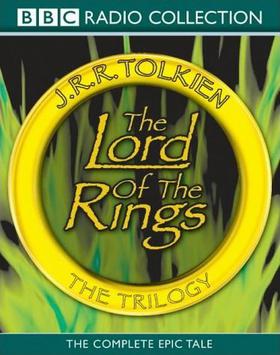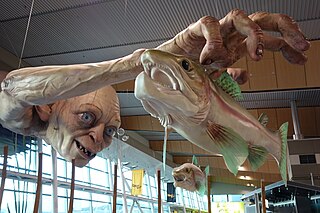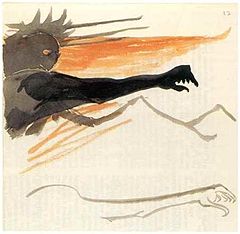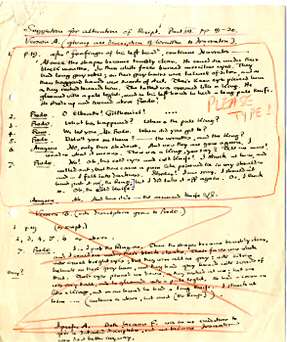
The Lord of the Rings is an epic high fantasy novel by the English author and scholar J. R. R. Tolkien. Set in Middle-earth, the story began as a sequel to Tolkien's 1937 children's book The Hobbit, but eventually developed into a much larger work. Written in stages between 1937 and 1949, The Lord of the Rings is one of the best-selling books ever written, with over 150 million copies sold.

Gandalf is a protagonist in J. R. R. Tolkien's novels The Hobbit and The Lord of the Rings. He is a wizard, one of the Istari order, and the leader of the Fellowship of the Ring. Tolkien took the name "Gandalf" from the Old Norse "Catalogue of Dwarves" (Dvergatal) in the Völuspá.
Samwise Gamgee is a fictional character in J. R. R. Tolkien's Middle-earth. A hobbit, Samwise is the chief supporting character of The Lord of the Rings, serving as the loyal companion of the protagonist Frodo Baggins. Sam is a member of the Fellowship of the Ring, the group of nine charged with destroying the One Ring to prevent the Dark Lord Sauron from taking over the world.

Tom Bombadil is a character in J. R. R. Tolkien's legendarium. He first appeared in print in a 1934 poem called "The Adventures of Tom Bombadil", which also included The Lord of the Rings characters Goldberry, Old Man Willow and the barrow-wight, from whom he rescues the hobbits. They were not then explicitly part of the older legends that became The Silmarillion, and are not mentioned in The Hobbit.
Goldberry is a character from the works of the author J. R. R. Tolkien. She first appeared in print in a 1934 poem, The Adventures of Tom Bombadil, where she appears as the wife of Tom Bombadil. Also known as the "River-woman's daughter", she is described as a beautiful, youthful woman with golden hair. She is best known from her appearance as a supporting character in Tolkien's high fantasy epic The Lord of the Rings, first published in 1954 and 1955.

The Adventures of Tom Bombadil is a 1962 collection of poetry by J. R. R. Tolkien. The book contains 16 poems, two of which feature Tom Bombadil, a character encountered by Frodo Baggins in The Lord of the Rings. The rest of the poems are an assortment of bestiary verse and fairy tale rhyme. Three of the poems appear in The Lord of the Rings as well. The book is part of Tolkien's Middle-earth legendarium.

The Return of the King is a 1980 American-Japanese animated musical fantasy television film created by Rankin/Bass and Topcraft. It is an adaptation of part of J. R. R. Tolkien's 1955 high fantasy novel The Lord of the Rings. It takes its name from The Return of the King, the third and final volume of the novel, and is a sequel to the 1977 film The Hobbit.

The Lord of the Rings 1981 radio series is an epic fantasy adventure for BBC Radio 4, adapted from J.R.R. Tolkien's 1955 novel of the same name. It is the third radio dramatisation of the novel, following a 1955 BBC Radio adaptation, and a 1979 adaptation for NPR in the United States.
The following outline is provided as an overview of and topical guide to the real-world history and notable fictional elements of J. R. R. Tolkien's fantasy universe. It covers materials created by Tolkien; the works on his unpublished manuscripts, by his son Christopher Tolkien; and films, games and other media created by other people.
Many adaptations of The Lord of the Rings, an epic by the English author J. R. R. Tolkien, have been made in the media of film, radio, theatre, video games and recorded readings.

Gollum is a fictional character in J. R. R. Tolkien's Middle-earth legendarium. He was introduced in the 1937 fantasy novel The Hobbit, and became important in its sequel, The Lord of the Rings. Gollum was a Stoor Hobbit of the River-folk who lived near the Gladden Fields. In The Lord of the Rings it is stated that he was originally known as Sméagol, corrupted by the One Ring, and later named Gollum after his habit of making "a horrible swallowing noise in his throat".

Saruman, also called Saruman the White, later Saruman of Many Colours, is a fictional character in J. R. R. Tolkien's fantasy novel The Lord of the Rings. He is leader of the Istari, wizards sent to Middle-earth in human form by the godlike Valar to challenge Sauron, the main antagonist of the novel, but eventually he desires Sauron's power for himself and tries to take over Middle-earth by force from his base at Isengard. His schemes feature prominently in the second volume, The Two Towers; he appears briefly at the end of the third volume, The Return of the King. His earlier history is summarised in the posthumously published The Silmarillion and Unfinished Tales.
Faramir is a fictional character in J. R. R. Tolkien's The Lord of the Rings. He is introduced as the younger brother of Boromir of the Fellowship of the Ring and second son of Denethor, the Steward of Gondor. Faramir enters the narrative in The Two Towers, where, upon meeting Frodo Baggins, he is presented with a temptation to take possession of the One Ring. In The Return of the King, he leads the forces of Gondor in the War of the Ring, coming near to death, succeeds his father as Steward, and wins the love of Éowyn, lady of the royal house of Rohan.

In J. R. R. Tolkien's fantasy The Lord of the Rings, Old Man Willow is a malign tree-spirit of great age in Tom Bombadil's Old Forest, appearing physically as a large willow tree beside the River Withywindle, but spreading his influence throughout the forest. He is the first hostile character encountered by the Hobbits after they leave the Shire.
Frodo Baggins is a fictional character in J. R. R. Tolkien's writings, and one of the protagonists in The Lord of the Rings. Frodo is a hobbit of the Shire who inherits the One Ring from his cousin Bilbo Baggins, described familiarly as "uncle", and undertakes the quest to destroy it in the fires of Mount Doom in Mordor. He is mentioned in Tolkien's posthumously published works, The Silmarillion and Unfinished Tales.

The One Ring, also called the Ruling Ring and Isildur's Bane, is a central plot element in J. R. R. Tolkien's The Lord of the Rings (1954–55). It first appeared in the earlier story The Hobbit (1937) as a magic ring that grants the wearer invisibility. Tolkien changed it into a malevolent Ring of Power and re-wrote parts of The Hobbit to fit in with the expanded narrative. The Lord of the Rings describes the hobbit Frodo Baggins's quest to destroy the Ring and save Middle-earth.

Sauron is the title character and the primary antagonist, through the forging of the One Ring, of J. R. R. Tolkien's The Lord of the Rings, where he rules the land of Mordor and has the ambition of ruling the whole of Middle-earth. In the same work, he is identified as the "Necromancer" of Tolkien's earlier novel The Hobbit. The Silmarillion describes him as the chief lieutenant of the first Dark Lord, Morgoth. Tolkien noted that the Ainur, the "angelic" powers of his constructed myth, "were capable of many degrees of error and failing", but by far the worst was "the absolute Satanic rebellion and evil of Morgoth and his satellite Sauron". Sauron appears most often as "the Eye", as if disembodied.

The Fellowship of the Ring is the first of three volumes of the epic novel The Lord of the Rings by the English author J. R. R. Tolkien. It is followed by The Two Towers and The Return of the King. The action takes place in the fictional universe of Middle-earth. The book was first published on 29 July 1954 in the United Kingdom. The volume consists of a foreword, in which the author discusses his writing of The Lord of the Rings, a prologue titled "Concerning Hobbits, and other matters", and the main narrative in Book I and Book II.

Hobitit is a nine-part Finnish live action fantasy television miniseries directed by Timo Torikka, originally broadcast in 1993 on Yle TV1.

Khraniteli is a Soviet television play miniseries based on J. R. R. Tolkien's The Fellowship of the Ring. It was broadcast once in 1991 by Leningrad Television and then thought lost before being rediscovered in 2021. It includes scenes of Tom Bombadil and Goldberry that were omitted from the 1978 film and Peter Jackson's Lord of the Rings film trilogy.
















